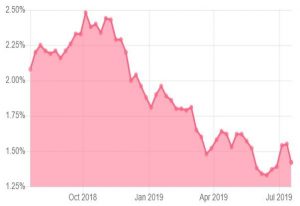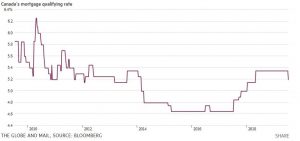August 29, 2019 – The C.D. Howe Institute’s Monetary Policy Council (MPC) has recommended that the Bank of Canada keep its target for the overnight rate, its benchmark policy interest rate, at 1.75 percent at its next announcement on September 4, 2019, before lowering it to 1.25 percent by March 2020.
The MPC provides an independent assessment of the monetary stance consistent with the Bank of Canada’s 2 percent inflation target. William Robson, the Institute’s President and CEO, chairs the Council. Council members make recommendations for the Bank of Canada’s upcoming interest-rate announcement, the subsequent announcement, and the announcements six months and one year ahead. The Council’s formal recommendation for each announcement is the median vote of the members attending the meeting.
Eight of the nine members attending this meeting called for the Bank to maintain the overnight rate target at 1.75 percent next week, while one called for a cut to 1.50 percent. By the next announcement in October, five of the members supported maintaining the target at 1.75 percent, three called for a cut to 1.50 percent, and one called for a cut to 1.25 percent. Looking ahead to March 2020, the centre of gravity of the recommendations shifted decisively down: one member called for maintaining the target at 1.75 percent, three called for 1.50 percent, and five called for 1.25 percent. By September 2020, one member called for a target of 1.75 percent, three for 1.50 percent, four for 1.25 percent, and one for 1.00 percent (see table).
The profile of these recommendations – no cut in the overnight rate in the near term, but 50 basis points lower after six months – reflected the contrast between the MPC’s sanguine assessment of the Canadian economy and its worries about problems abroad. The group generally judged that economic activity in Canada is expanding at about the same pace as productive capacity is growing, and that the Bank’s current stance is appropriate for maintaining inflation at 2 percent. Looking outside Canada, however, most members thought that the downside risks were numerous and important enough to warrant at least one cut in the overnight rate target over the next 12 months.
Among the domestic indicators MPC members cited as supporting an unchanged policy stance were employment growth and rising wages, a better balance among consumption, housing, business investment and net exports, and a recovery from temporary factors slowing growth late in 2018 and in the first quarter of 2019. On the cautionary side, and reflecting in large part concerns about the outlook abroad, they noted the inversion of the yield curve and financial market expectations of below-target inflation and central bank easing. The MPC’s discussion of risks to the global economy highlighted a deteriorating growth outlook in most major economies, Brexit, and the prospect that trade tensions, particularly between the United States and China, will further damage confidence and activity.
Much of the discussion at this meeting of the MPC turned on the timing of potential cuts to the overnight rate target. Some members argued that cutting earlier would leave the Canadian economy in better shape should some of the downside risks materialize; others argued for conserving a cut until that happened. Potential actions by the US Federal Reserve and other central banks were material considerations for many members, who argued that easing abroad would put undesirable upward pressure on the Canadian dollar if the Bank of Canada did not ease also. The prospect of policy-rate cuts abroad was significant in the MPC’s call for a lower overnight rate by early 2020.
Votes of MPC members and the Council median for each announcement, percent
| Sept 4 | Oct 30 | March 2020 | Sept 2020 | |
| Steve Ambler
Université du Québec à Montréal(UQAM) |
1.75 | 1.75 | 1.75 | 1.75 |
| Beata Caranci
TD Bank Group |
1.75 | 1.50 | 1.25 | 1.25 |
| Edward A. Carmichael
Ted Carmichael Global Macro |
1.50 | 1.25 | 1.25 | 1.25 |
| Thorsten Koeppl
Queen’s University |
1.75 | 1.75 | 1.25 | 1.00 |
| Angelo Melino
University of Toronto |
1.75 | 1.50 | 1.25 | 1.25 |
| Jean-François Perrault
Scotiabank |
1.75 | 1.50 | 1.25 | 1.25 |
| Avery Shenfeld
CIBC |
1.75 | 1.75 | 1.50 | 1.50 |
| Pierre Siklos
Wilfrid Laurier University |
1.75 | 1.75 | 1.50 | 1.50 |
| Craig Wright
RBC |
1.75 | 1.75 | 1.50 | 1.50 |
| Median Vote | 1.75 | 1.75 | 1.25 | 1.25 |
The views and opinions expressed by the participants are their own and do not necessarily reflect the views of the organizations with which they are affiliated, or those of the C.D. Howe Institute.
The MPC’s next vote will take place on October 24, 2019 prior to the Bank of Canada’s interest rate announcement on October 30, 2019.
Angela Calla is a 15 year award-winning woman of influence mortgage expert. Alongside her team, passionately assisting mortgage holders get the best mortgage, and educating them on The Mortgage Show on CKNW for over a decade and through her best-selling book The Mortgage Code available on Amazon. To purchase the book click here: The Mortgage Code. Proceeds from a sales will help build a new emergency room at Eagle Ridge Hospital. Angela can be reached at callateam@dominionlending.ca or 604-802-3983.
Council Report



